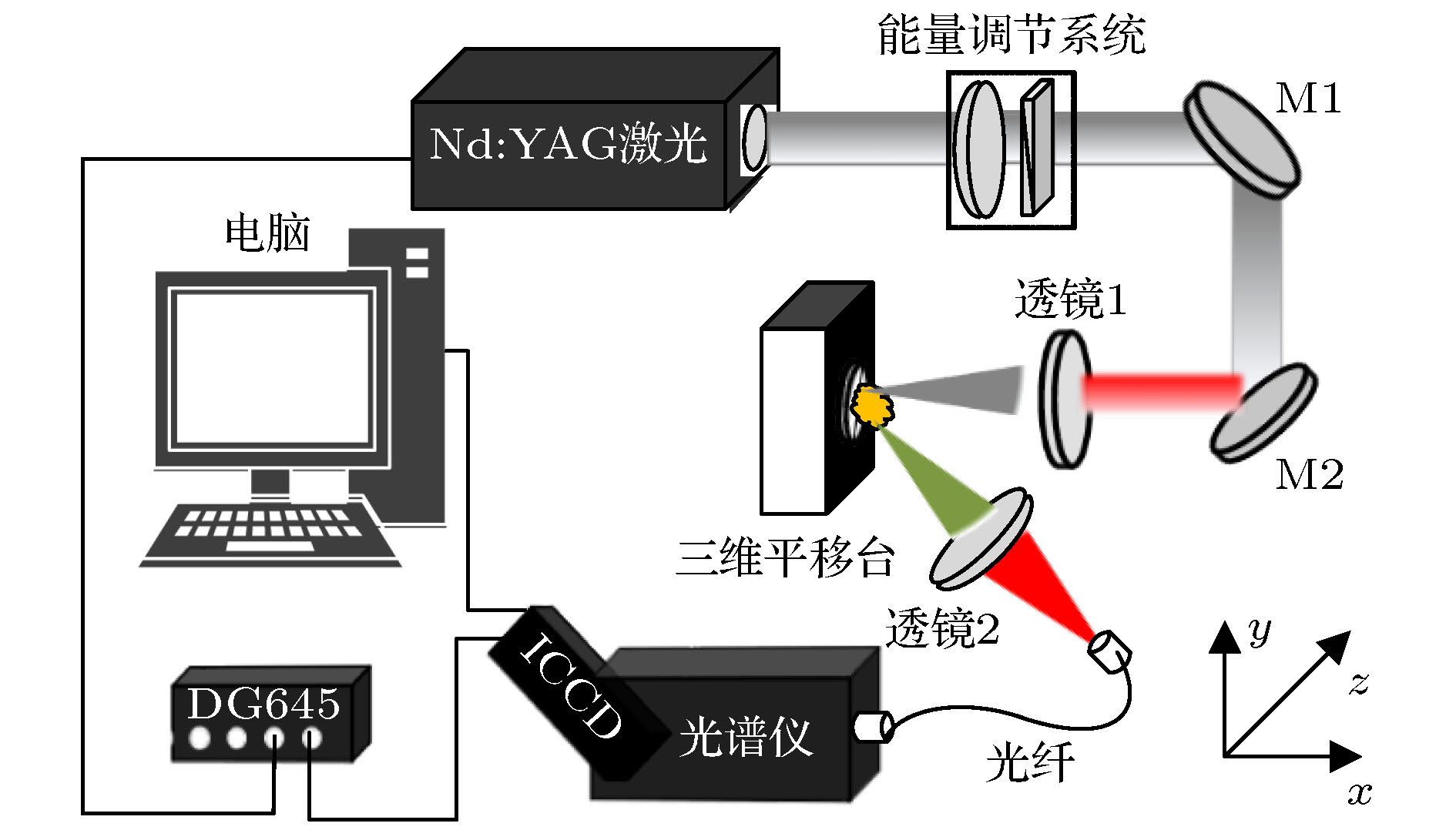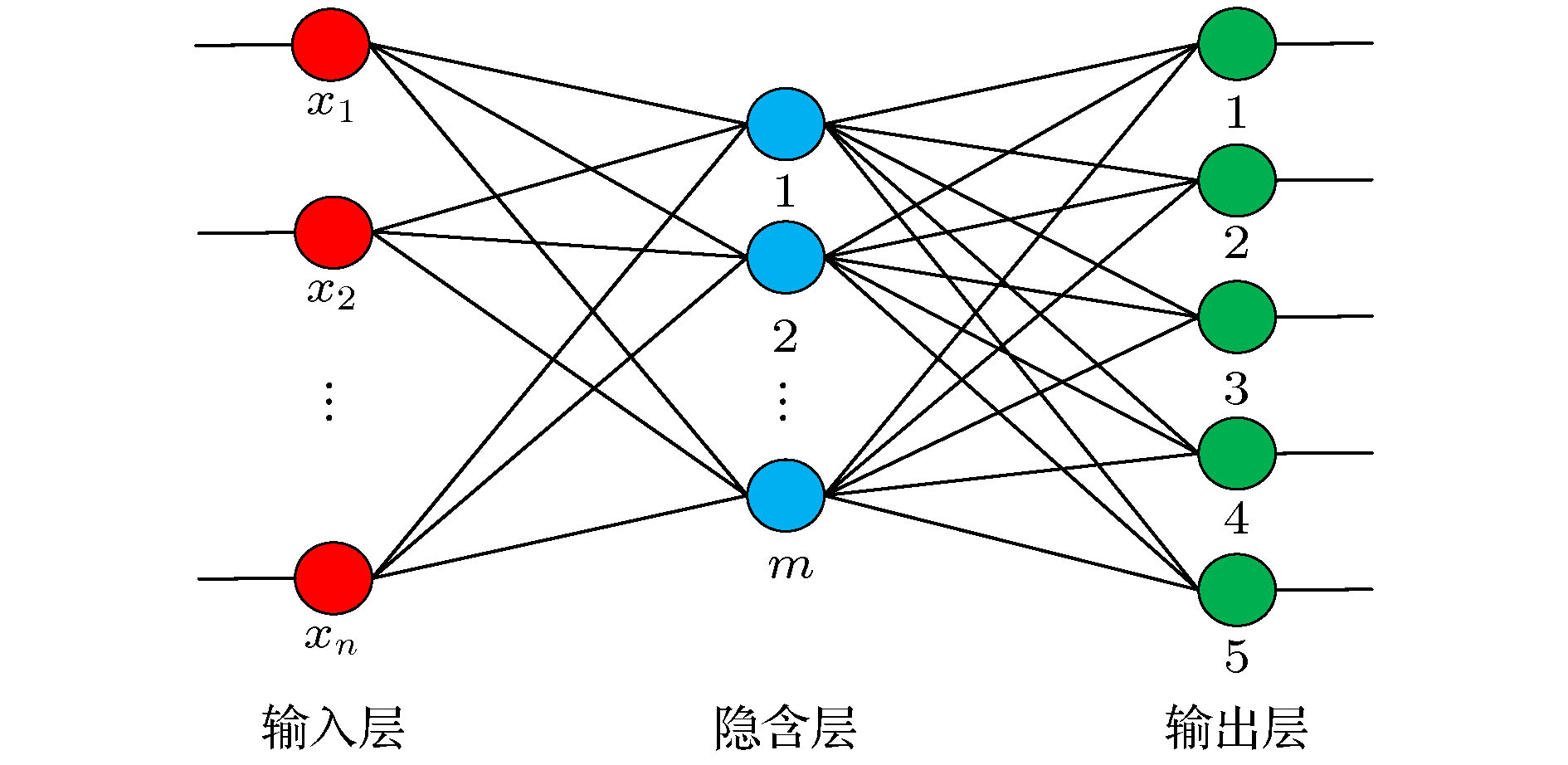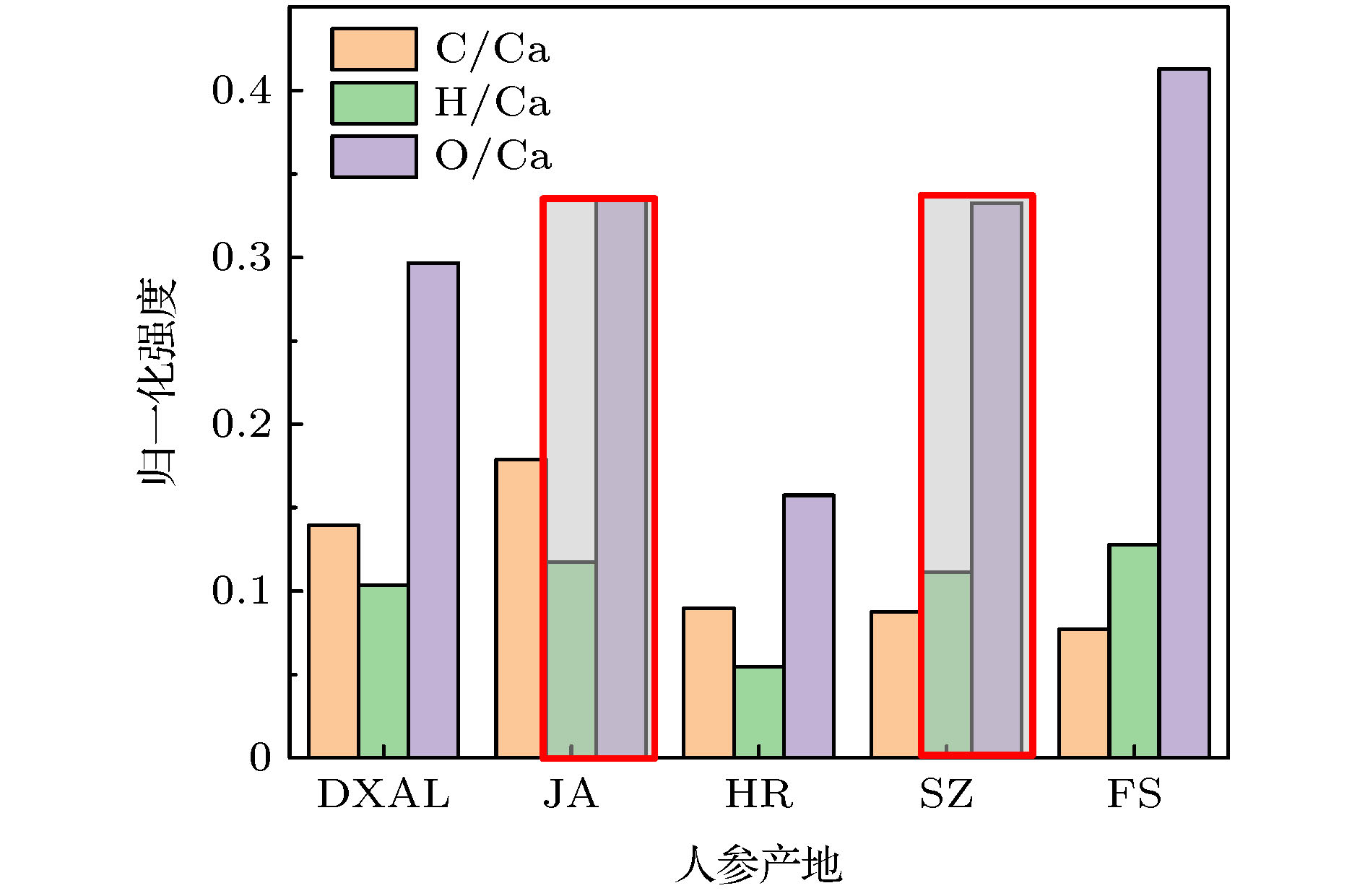-
利用激光诱导击穿光谱技术结合机器学习算法, 对东北5个产地(大兴安岭、集安、恒仁、石柱、抚松)的人参进行产地识别, 建立了主成分分析算法分别结合反向传播(BP)神经网络和支持向量机算法的人参产地识别模型. 实验采集了5个产地人参共657组在200—975 nm的激光诱导击穿光谱, 经光谱数据预处理后, 对C, Mg, Ca, Fe, H, N, O等元素的8条特征谱线进行主成分分析, 原光谱数据的前3个主成分累积贡献率达到92.50%, 且样品在主成分空间中呈现良好的聚集分类. 降维后的前3个主成分以2∶1进行随机抽取, 分别作为分类算法的训练集和测试集. 实验结果表明主成分分析结合BP神经网络及支持向量机的平均识别率分别为99.08%和99.5%. 发生误判的原因是集安和石柱两地地理环境的接近而导致的H, O两元素在Ca元素离子发射谱线下的归一化强度相似. 本研究为激光诱导击穿光谱技术在人参产地的快速识别提供了方法和参考.Based on laser-induced breakdown spectroscopy and machine learning algorithms, ginseng origin identification model is established by principal component analysis algorithm combined with back-propagation (BP) neural network and support vector machine algorithm to analyze and identify ginseng from five different origins in northeast China (Daxinganling, Ji’an, Hengren, Shizhu, and Fusong). The experiment collects a total of 657 groups of laser-induced breakdown spectral data from five origins of ginseng at 200–975 nm, reduces the background continuous spectrum of the original spectral data by moving window smoothing method, labels the ginseng LIBS spectral elements according to the American NIST atomic spectral database. Eight characteristic spectral lines of 7 elements Mg, Ca, Fe, C, H, N and O are selected for principal component analysis according to characteristic spectral selection conditions. The cumulative contribution rate of the first three principal components of the original spectral data reaches 92.50%, which represents a large amount of information about the original ginseng LIBS spectrum, and the samples show a good aggregation and classification in the principal component space. After dimension reduction, the first three principal components are randomly selected in a ratio of 2 to 1 and divided into 438 test sets and 219 training sets, which are used as the input values of the classification algorithm. The experimental results show that the principal component analysis combined with the BP neural network algorithm and support vector machine algorithm can correctly identify 217 and 218 spectra of 219 spectra of the test set respectively, and the average recognition rate is 99.08% and 99.5% respectively. The modeling time of BP neural network is 11.545 s shorter than that of the support vector machine. Both models misjudged Ji'an Ginseng as Shi zhu ginseng, and the reason for this misjudgment is that the normalized intensity of H and O under Ca element ion emission spectrum are similar due to the proximity of Ji 'an to Shi Zhu in geographical environment. The study presented here demonstrates that laser-induced breakdown spectroscopy combined with machine learning algorithm is a useful technology for rapid identification of ginseng origin and is expected to realize automatic, real-time, rapid and reliable discrimination.
-
Keywords:
- laser-induced breakdown spectroscopy /
- machine learning algorithm /
- identification of origin /
- ginseng
[1] Patel S, Rauf A 2017 Biomed. Pharmacother. 85 120
 Google Scholar
Google Scholar
[2] Kim J H 2018 J. Ginseng Res. 42 264
 Google Scholar
Google Scholar
[3] Huang Y, Gou M J, Jiang K, Wang L J, Yin G, Wang J, Wang P, Tu J S, Wang T J 2019 Appl. Spectrosc. Rev. 54 653
 Google Scholar
Google Scholar
[4] Bec K B, Grabska J, Kirchler C G, Huck C W 2018 J. Mol. Liq. 268 895
 Google Scholar
Google Scholar
[5] Chen J B, Sun S Q, Ma F, Zhou Q 2014 Spectrochim. Acta, Part A 128 629
 Google Scholar
Google Scholar
[6] Fan Q, Chen C, Huang Z, Zhang C M, Liang P J, Zhao S L 2015 Spectrochim. Acta, Part A 136 1621
 Google Scholar
Google Scholar
[7] Radziemski L, Cremers D 2013 Spectrochim. Acta, Part B 87 3
 Google Scholar
Google Scholar
[8] 邵妍, 张艳波, 高勋, 杜闯, 林景全 2013 光谱学与光谱分析 33 2593
 Google Scholar
Google Scholar
Shao Y, Zhang Y B, Gao X, Du C, Lin J Q 2013 Spectrosc. Spectr. Anal. 33 2593
 Google Scholar
Google Scholar
[9] Costa V C, Augusto A S, Castro J P, Machado R C, Andrade D F, Babos D V, Speranca M A, Gamela R R, Pereira E R 2019 Quim. Nova 42 527
[10] Gottfried J L, Jr F C D L, Munson C A, Miziolek A W 2009 Anal. Bioanal. Chem. 395 283
 Google Scholar
Google Scholar
[11] Tzortzakis S, Anglos D, Gray D 2006 Opt. Lett. 31 1139
 Google Scholar
Google Scholar
[12] Kaiser J, Novotny K, Martin M Z, Hrdlicka A, Malina R, Hartl M, Adam V, Kizek R 2012 Surf. Sci. Rep. 67 233
 Google Scholar
Google Scholar
[13] 谷艳红, 赵南京, 马明俊, 孟德硕, 贾尧, 方丽, 刘建国, 刘文清 2018 光谱学与光谱分析 38 982
Gu Y H, Zhao N J, Ma M J, Meng D S, Jia Y, Fang L, Liu J G, Liu W Q 2018 Spectrosc. Spectr. Anal. 38 982
[14] Choi J J, Choi S J, Yoh J J 2016 Appl. Spectrosc. 70 1411
 Google Scholar
Google Scholar
[15] Yao M Y, Yang H, Huang L, Chen T B, Rao G F, Liu M H 2017 Appl. Opt. 56 4070
 Google Scholar
Google Scholar
[16] Junjuri R, Gundawar M K 2019 J. Anal. At. Spectrom. 34 1683
 Google Scholar
Google Scholar
[17] Velioglu H M, Sezer B, Bilge G, Baytur S E, Boyaci Il H 2018 Meat Sci. 138 28
 Google Scholar
Google Scholar
[18] Lin J J, Lin X E, Guo L B, Guo Y M, Tang Y, Chu Y W, Tang S S, Che C J 2018 J. Anal. At. Spectrom. 33 1545
 Google Scholar
Google Scholar
[19] Wang J M, Liao X Y, Zheng P C, Xue S W, Peng R 2017 Anal. Lett. 51 575
[20] 郑培超, 郑爽, 王金梅, 廖香玉, 李晓娟, 彭锐 2020 光谱学与光谱分析 40 941
Zheng P C, Zheng S, Wang J M, Liao X Y, Li X J, Peng R 2020 Spectrosc. Spectr. Anal. 40 941
[21] Koujelev A, Sabsabi M, Ros V M, Laville S, Lui S L 2010 Planet. Space Sci. 58 682
 Google Scholar
Google Scholar
[22] 于洋, 郝中骐, 李常茂, 郭连波, 李阔湖, 曾庆栋, 李祥友, 任昭, 曾晓雁 2013 物理学报 62 215201
 Google Scholar
Google Scholar
Yu Y, Hao Z Q, Li C M, Guo L B, Li K H, Zeng Q D, Li X Y, Ren Z, Zeng X Y 2013 Acta Phys. Sin. 62 215201
 Google Scholar
Google Scholar
-
表 1 人参特征谱线及波长
Table 1. Characteristic line and wavelength of ginseng.
元素 波长/nm C I 247.80 Mg II 279.56 Ca II 393.40; 396.87 Fe I 422.71 H I 656.39 N I 747.07 O I 777.42 表 2 人参产地识别结果对比
Table 2. Comparison of ginseng origin identification results.
算法 测试集识别结果 平均识别精度 建模时间/s 产地 识别精度 PCA-BP DXAL 100% JA 96% HR 100% 99.08% 2.48 SZ 100% FS 100% PCA-SVM DXAL 100% JA 98% HR 100% 99.5% 14.03 SZ 100% FS 100% -
[1] Patel S, Rauf A 2017 Biomed. Pharmacother. 85 120
 Google Scholar
Google Scholar
[2] Kim J H 2018 J. Ginseng Res. 42 264
 Google Scholar
Google Scholar
[3] Huang Y, Gou M J, Jiang K, Wang L J, Yin G, Wang J, Wang P, Tu J S, Wang T J 2019 Appl. Spectrosc. Rev. 54 653
 Google Scholar
Google Scholar
[4] Bec K B, Grabska J, Kirchler C G, Huck C W 2018 J. Mol. Liq. 268 895
 Google Scholar
Google Scholar
[5] Chen J B, Sun S Q, Ma F, Zhou Q 2014 Spectrochim. Acta, Part A 128 629
 Google Scholar
Google Scholar
[6] Fan Q, Chen C, Huang Z, Zhang C M, Liang P J, Zhao S L 2015 Spectrochim. Acta, Part A 136 1621
 Google Scholar
Google Scholar
[7] Radziemski L, Cremers D 2013 Spectrochim. Acta, Part B 87 3
 Google Scholar
Google Scholar
[8] 邵妍, 张艳波, 高勋, 杜闯, 林景全 2013 光谱学与光谱分析 33 2593
 Google Scholar
Google Scholar
Shao Y, Zhang Y B, Gao X, Du C, Lin J Q 2013 Spectrosc. Spectr. Anal. 33 2593
 Google Scholar
Google Scholar
[9] Costa V C, Augusto A S, Castro J P, Machado R C, Andrade D F, Babos D V, Speranca M A, Gamela R R, Pereira E R 2019 Quim. Nova 42 527
[10] Gottfried J L, Jr F C D L, Munson C A, Miziolek A W 2009 Anal. Bioanal. Chem. 395 283
 Google Scholar
Google Scholar
[11] Tzortzakis S, Anglos D, Gray D 2006 Opt. Lett. 31 1139
 Google Scholar
Google Scholar
[12] Kaiser J, Novotny K, Martin M Z, Hrdlicka A, Malina R, Hartl M, Adam V, Kizek R 2012 Surf. Sci. Rep. 67 233
 Google Scholar
Google Scholar
[13] 谷艳红, 赵南京, 马明俊, 孟德硕, 贾尧, 方丽, 刘建国, 刘文清 2018 光谱学与光谱分析 38 982
Gu Y H, Zhao N J, Ma M J, Meng D S, Jia Y, Fang L, Liu J G, Liu W Q 2018 Spectrosc. Spectr. Anal. 38 982
[14] Choi J J, Choi S J, Yoh J J 2016 Appl. Spectrosc. 70 1411
 Google Scholar
Google Scholar
[15] Yao M Y, Yang H, Huang L, Chen T B, Rao G F, Liu M H 2017 Appl. Opt. 56 4070
 Google Scholar
Google Scholar
[16] Junjuri R, Gundawar M K 2019 J. Anal. At. Spectrom. 34 1683
 Google Scholar
Google Scholar
[17] Velioglu H M, Sezer B, Bilge G, Baytur S E, Boyaci Il H 2018 Meat Sci. 138 28
 Google Scholar
Google Scholar
[18] Lin J J, Lin X E, Guo L B, Guo Y M, Tang Y, Chu Y W, Tang S S, Che C J 2018 J. Anal. At. Spectrom. 33 1545
 Google Scholar
Google Scholar
[19] Wang J M, Liao X Y, Zheng P C, Xue S W, Peng R 2017 Anal. Lett. 51 575
[20] 郑培超, 郑爽, 王金梅, 廖香玉, 李晓娟, 彭锐 2020 光谱学与光谱分析 40 941
Zheng P C, Zheng S, Wang J M, Liao X Y, Li X J, Peng R 2020 Spectrosc. Spectr. Anal. 40 941
[21] Koujelev A, Sabsabi M, Ros V M, Laville S, Lui S L 2010 Planet. Space Sci. 58 682
 Google Scholar
Google Scholar
[22] 于洋, 郝中骐, 李常茂, 郭连波, 李阔湖, 曾庆栋, 李祥友, 任昭, 曾晓雁 2013 物理学报 62 215201
 Google Scholar
Google Scholar
Yu Y, Hao Z Q, Li C M, Guo L B, Li K H, Zeng Q D, Li X Y, Ren Z, Zeng X Y 2013 Acta Phys. Sin. 62 215201
 Google Scholar
Google Scholar
计量
- 文章访问数: 9078
- PDF下载量: 184
- 被引次数: 0














 下载:
下载:






